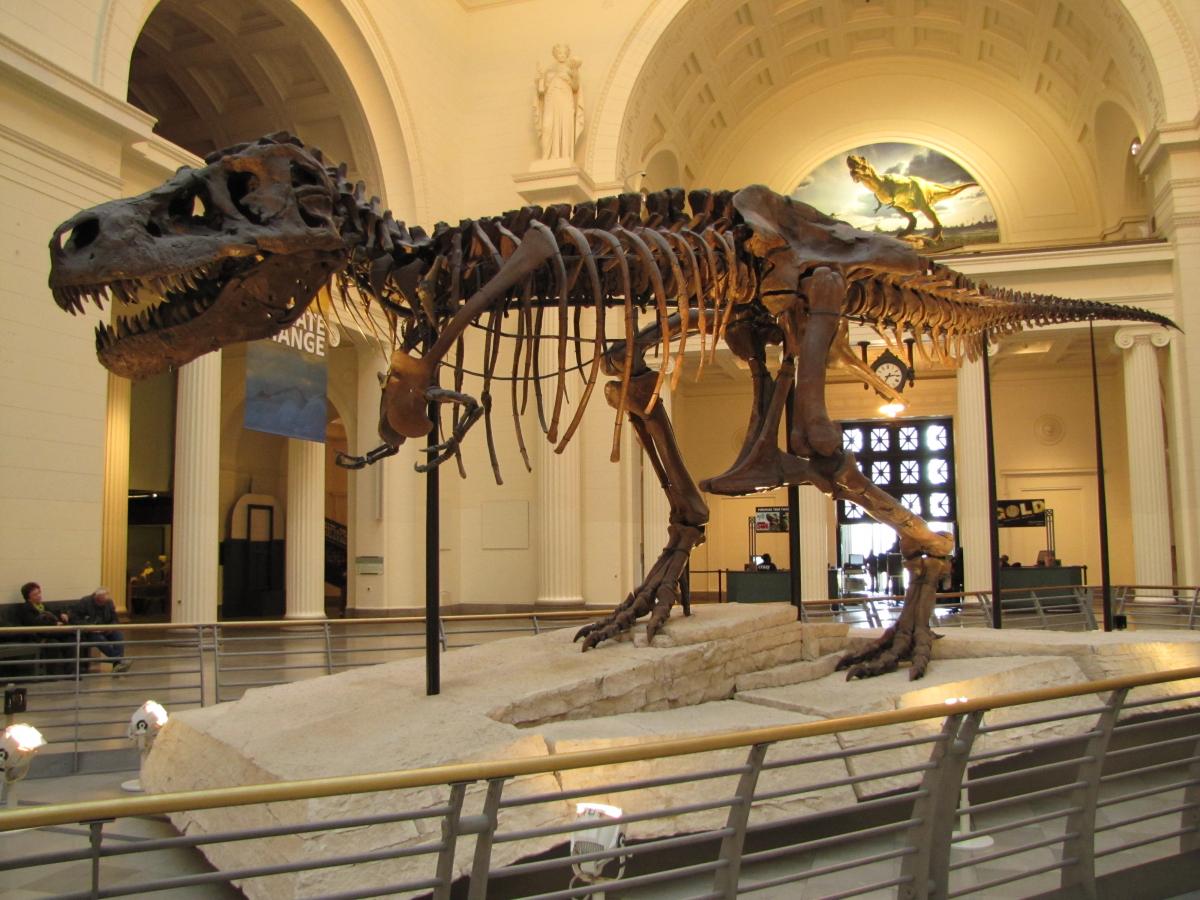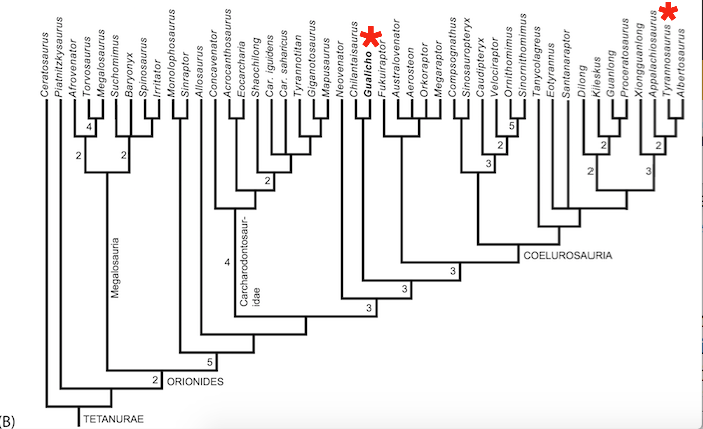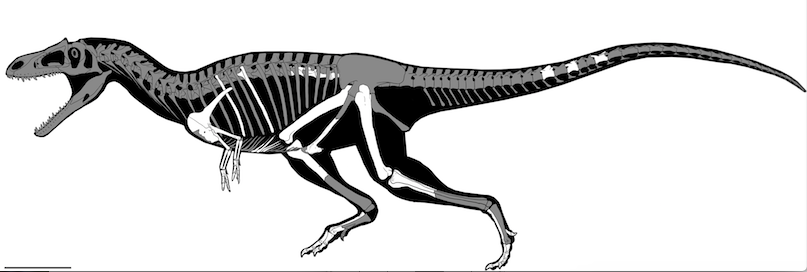 “Silly,” “comically short,” “feeble,” “itty-bitty,” “teeny-tiny,” “useless,” and “wimpy” are not generally phrases you’d associate with a fearsome predator, but they are just some of the adjectives science writers used to describe the fiercest of the fierce—T. rex…or its arms, anyway. New research published this month had the science community awash with T. rex talk because it described a newly discovered dinosaur with T. rex-esque arms. That is to say, with arms disproportionally small compared to its overall body size and ended with just two fingers. The new dinosaur, called Gualicho shinyae, discovered in Argentina back in 2007 (remember, it takes a long time to extract, clean up, and describe a fossil!), was about the size of a polar bear but had arms about as long as your average elementary-school-aged child.
“Silly,” “comically short,” “feeble,” “itty-bitty,” “teeny-tiny,” “useless,” and “wimpy” are not generally phrases you’d associate with a fearsome predator, but they are just some of the adjectives science writers used to describe the fiercest of the fierce—T. rex…or its arms, anyway. New research published this month had the science community awash with T. rex talk because it described a newly discovered dinosaur with T. rex-esque arms. That is to say, with arms disproportionally small compared to its overall body size and ended with just two fingers. The new dinosaur, called Gualicho shinyae, discovered in Argentina back in 2007 (remember, it takes a long time to extract, clean up, and describe a fossil!), was about the size of a polar bear but had arms about as long as your average elementary-school-aged child.
T. rex’s small arms are certainly striking, and yes, I suppose, comical (check out the Tumblrs “T. rex trying” or “Things a T. rex can’t do” for examples), but I’d never want to meet one in the woods or a dark alley, so I generally refrain from name-calling. I also try to refrain, as ever, from too insistently asking the tempting question “What were their little arms for?” because, for all we know, they weren’t for anything (see: belly button). With its little arms T. rex survived peachily for at least two million years before a giant meteorite ended the party (see: Chicxulub impactor). So who are we to point the fingers at the end of our well-proportioned arms and laugh?
The newly discovered dinosaur adds a new dimension to this conversation, however, and that’s really what I want to talk about. When you see species with the same trait, there are generally two broad classes of evolutionary explanations. Either each species inherited the trait from a common ancestor, or each species evolved the trait independently (convergent evolution). To decide which scenario is more plausible, evolutionary biologists follow the law of parsimony. The law of parsimony is really a variation of Occam’s Razor, and can be boiled down to this: The simplest hypothesis that explains the facts is the preferred hypothesis, other things being equal.
Let’s consider mammals. All mammals have hair at some point in their development (some adult whales that don’t have hair do have it in utero). It is possible that each mammal species evolved hair independently along its lineage (like Oprah, right? You get hair! And you get hair! And you get hair!), but a far simpler hypothesis is that all mammals inherited hair from a common ancestor. Why is it simpler? Because it assumes only that the trait evolved once—not thousands of times.

Back to the dinosaurs. Our new dino friend, Gualicho shinyae, had reduced arms just like T. rex. So the question arises: was this trait inherited from a common ancestor, or did it evolve independently? Well, it turns out that you have to go pretty far back along each species’s lineage to find the common ancestor—T. rex and G. shinyae were distant, not close, cousins. Many other dinosaur species were much more closely related, and they had proportional arms, not tiny arms. So the two contending hypotheses are (1) the common ancestor of T. rex and G. shinyae had reduced arms, which were maintained by T. rex and G. shinyae while all of the closer cousins independently evolved robust arms and (2) the common ancestor of T. rex and G. shinyae had robust arms and T. rex and G. shinyae each independently evolved reduced arms. Following the law of parsimony, the latter hypothesis is favored.
Okay, so two species of predatory dinosaurs each independently evolved reduced arms. That is an intriguing finding because it seems to suggest that there was some advantage associated with the trait. Notice that I didn’t say that the arms themselves must have been advantageous, only that there is likely to have been at least an advantage associated with it. So I stand by my earlier warning that asking what the little arms are “for” is not necessarily the right question to ask—rather, we should be asking what advantage did they confer, or even what non-arm-related advantage might have resulted in tiny arms.

The best suggestions I found were in the The Washington Post’s Speaking of Science blog, where Rachel Feldman writes that “smaller [fore]limbs might have made these ferocious dinosaurs more nimble hunters.” Paleontologist Thomas Holtz Jr. added, “Reducing the arms was probably ‘beneficial’ in that they got them out of the way of the more powerful jaws.” Reducing the size of the forelimbs would have carried the benefits of reducing overall energy expenditure and making room for more robust musculature in the torso and neck—all the better to chomp you in two, my dear.
I find all of these suggestions compelling. You’ll note that none of them answer the question of what were the little arms for. If these hypotheses are right, they weren’t for anything; rather, they are the outcome of selection for other advantages. In this way, they are a bit like Lewontin and Gould’s famous spandrels—the consequence of other functional and beneficial characteristics. The advantages of having small arms outweighed any disadvantages, and thus they evolved—at least twice—among dinosaurs.
So can we all put our hands together to applaud Sebastián Apesteguía and his colleagues for their research? I mean, those of us who aren’t T. rex or G. shinyae?
Are you a teacher and want to tell us about an amazing free resource? Do you have an idea for a Misconception Monday or other type of post? Have a fossil to share? See some good or bad examples of science communication lately? Drop me an email or shoot me a Tweet @keeps3.

